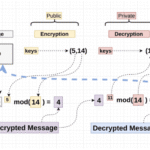When delving into the fundamental concepts of cryptography, one encounters a fascinating dichotomy between symmetric and asymmetric encryption. Among these, symmetric encryption stands out as remarkably swift. To comprehend the underlying causes of this rapidity, it is essential to unravel the intricate mechanics that govern symmetric encryption algorithms and their operational efficiencies.
Understanding the Mechanism of Symmetric Encryption
At its core, symmetric encryption employs a single key for both encryption and decryption processes. This simplicity breeds a multitude of advantages, primarily speed. Take, for instance, renowned algorithms such as AES (Advanced Encryption Standard). These algorithms are meticulously designed to operate efficiently on large blocks of data, enhancing throughput while employing minimal computational resources.
In symmetric encryption, the very architecture of the algorithms plays a pivotal role. Rather than engaging in the complex mathematical operations found in asymmetric counterparts, symmetric methods utilize basic operations such as substitution and permutation. This streamlined approach reduces processing time significantly, allowing for rapid data transformation.
A Closer Look at Algorithmic Efficiency
To grasp why symmetric encryption boasts such speed, one must consider key aspects of algorithm design. Many symmetric algorithms, including DES (Data Encryption Standard) and AES, operate using fixed block sizes—16 bytes for AES, for instance. The consistency of this block size enables the algorithms to be optimized for speed and performance across a range of platforms.
This is further augmented by the efficient handling of data in hardware. Modern processors often have specialized instruction sets that can execute encryption algorithms natively. This hardware acceleration drastically reduces the computational burden, leading to lightning-fast encryption and decryption operations. Hence, symmetric encryption is not solely about the algorithmic efficiency; it is also about how those algorithms are executed in the face of contemporary technological advancements.
The Role of Key Management and Security
Another salient feature of symmetric encryption is its key management challenge, which, paradoxically, is both a limitation and an asset. The necessity of sharing a secret key securely can initially seem daunting. However, when compared to asymmetric encryption, where key pairs create an intricate web of public and private keys, the simplicity of using one key reduces operational pitfalls. The swift key exchange can be conducted through simpler, less time-consuming means, making the overall system both secure and fast.
This efficiency in key management becomes critical in scenarios requiring real-time encryption. Consider applications in video streaming or online gaming, where instantaneous data transmission is not just preferable but essential. Utilizing symmetric encryption in these contexts allows for seamless user experiences without significant latency.
The Impact of Data Parallelism
Data parallelism represents another factor that contributes to the speed of symmetric encryption. Modern cryptographic implementations are adept at processing multiple data blocks simultaneously. Through parallel processing, which capitalizes on multi-core processors, symmetric encryption can achieve even higher levels of throughput. As a result, contemporary symmetric encryption facilitates a staggering volume of data to be encrypted in mere fractions of a second.
Moreover, many symmetric encryption algorithms are designed with parallelization in mind. For instance, the Galois/Counter Mode (GCM) combines encryption with data authentication, allowing operations on different data segments to occur concurrently—an endeavor that turbocharges performance metrics.
Storage and Bandwidth Considerations
The preference for symmetric encryption in many scenarios can also be attributed to its lower storage requirements. The fixed-size keys used in symmetric encryption are generally shorter than their asymmetric counterparts. This means that storage overhead is significantly less, a factor that becomes crucial when dealing with massive datasets or resource-constrained environments.
In addition, symmetric encryption typically consumes less bandwidth during the key exchange process. Given that only one key is transmitted, the energy and bandwidth expended are minimized, allowing for faster and more efficient data transfers across networks, thus solidifying the case for symmetric encryption in a fast-paced digital landscape.
The Psychological Aspect of Speed
Finally, the perception of speed plays a vital role in the adoption of symmetric encryption. In an era where information moves at breakneck velocity, users often remain oblivious to the cryptographic intricacies at play. They prioritize responsiveness and efficiency, and symmetric encryption delivers on those fronts with aplomb. The instinctive trust users place in systems that operate swiftly underscores the psychological dimension of cryptographic technologies—perhaps leading to broader acceptance and reliance on these faster, yet robustly secure systems.
Conclusion: The Future of Symmetric Encryption
Symmetric encryption, with its remarkable speed, constitutes a cornerstone of contemporary cryptographic practices. Through efficient algorithms, streamlined processes, and the interplay of hardware advancements, symmetric encryption delivers rapid performance without compromising security. As our reliance on digital communication continues to burgeon, understanding and leveraging the assets of symmetric encryption will prove essential for individuals and organizations alike. In the ever-evolving landscape of cryptography, symmetric encryption emerges not merely as a choice but as an imperative for anyone committed to safeguarding their data swiftly and efficiently.








Leave a Comment